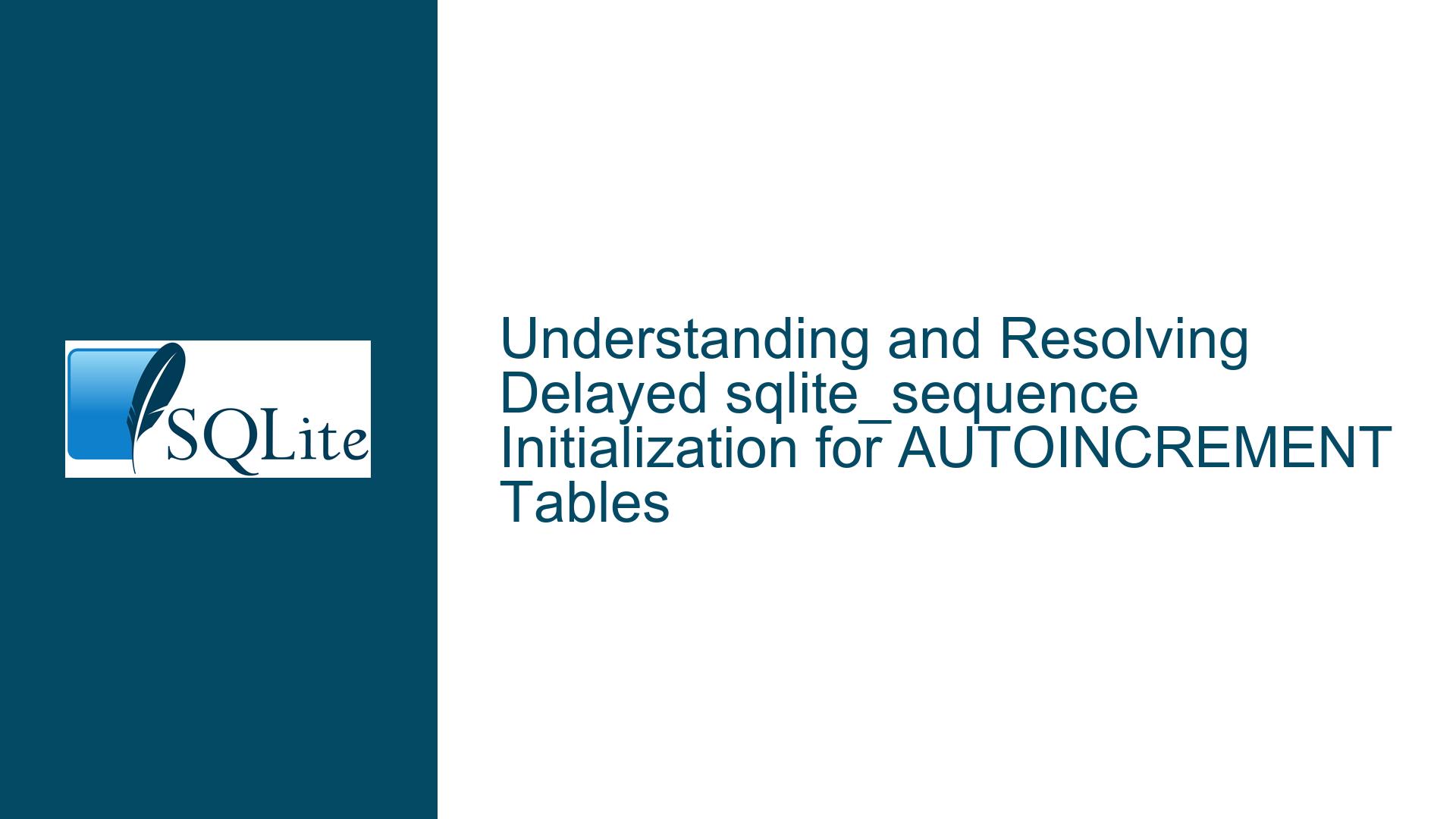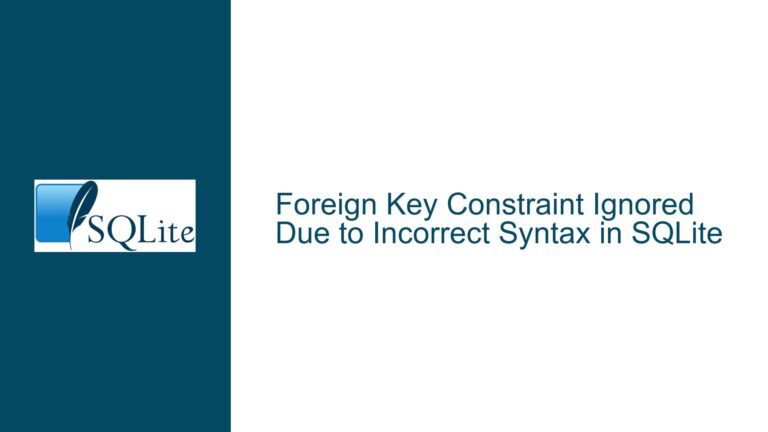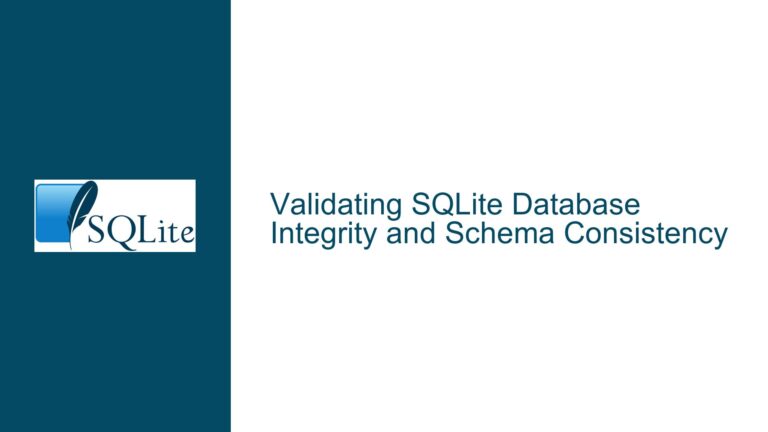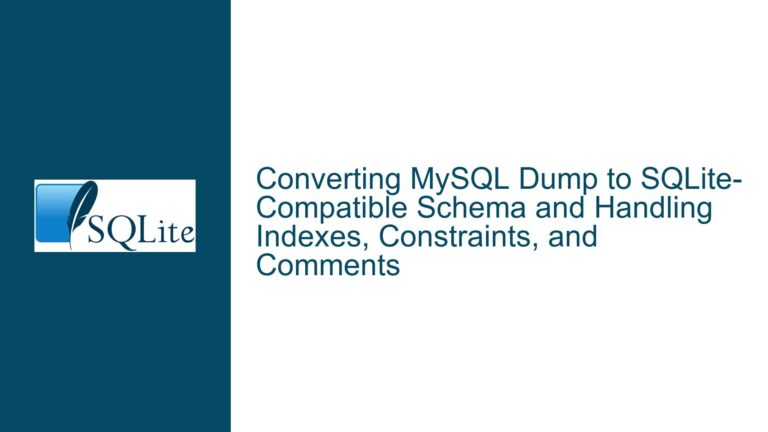and Resolving Delayed sqlite_sequence Initialization for AUTOINCREMENT Tables
sqlite_sequence Behavior with Newly Created AUTOINCREMENT Tables
The core issue revolves around SQLite’s handling of the internal sqlite_sequence table when working with tables containing AUTOINCREMENT columns. When developers create a table with an INTEGER PRIMARY KEY AUTOINCREMENT column, SQLite automatically generates the sqlite_sequence system table if it doesn’t already exist. However, the table-specific sequence tracking entry within sqlite_sequence doesn’t appear until after the first successful insert operation into the new table. This creates observable gaps in sequence management:
Immediate Creation of System Table:
Thesqlite_sequencetable appears in the database schema immediately upon creating any table withAUTOINCREMENT, visible through commands like.tablesorSELECT name FROM sqlite_master. This fulfills part of SQLite’s documentation about automatic table creation.Delayed Row Initialization:
The critical implementation detail is that SQLite doesn’t insert a corresponding row intosqlite_sequencefor the new table until the first successful INSERT operation occurs. Before this initial insert, queryingsqlite_sequencereturns no records for the table, even though the system table itself exists.Transaction Rollback Complications:
This design becomes problematic in scenarios requiring sequence manipulation before any successful insert, particularly when handling transaction rollbacks. If a transaction creates anAUTOINCREMENTtable, attempts to pre-configure sequence values throughsqlite_sequencewill fail because the sequence row doesn’t exist until after an insert commits.Documentation Clarification:
Recent updates to SQLite’s documentation emphasize that while thesqlite_sequencetable is created when the firstAUTOINCREMENTtable is defined, individual sequence entries are only initialized during the first insert operation. This clarifies that the "automatic initialization" refers to table creation rather than row population.
Design Constraints and Transactional Mechanics of Sequence Tracking
Three fundamental aspects of SQLite’s architecture explain this behavior:
A. Space Optimization in System Tables
SQLite avoids populating sqlite_sequence with zero-initialized entries to prevent unnecessary storage consumption. A database with hundreds of AUTOINCREMENT tables that never receive inserts would otherwise waste space storing (name, 0) records. The engine defers row creation until the first actual use.
B. ROWID Management Implementation
The AUTOINCREMENT feature in SQLite works by ensuring monotonically increasing ROWIDs even after row deletions. This is implemented by storing the maximum ROWID ever used in sqlite_sequence. Until a row is inserted, there’s no maximum ROWID to track, making premature initialization of the sequence value logically inconsistent.
C. Transaction Atomicity Requirements
SQLite’s transaction model requires that modifications to system tables like sqlite_sequence be atomic with user data changes. If a transaction creates an AUTOINCREMENT table and inserts its first row, the sqlite_sequence update occurs as part of that transaction. Initializing the sequence prematurely outside of an insert transaction would violate ACID principles by creating uncommitted system table changes.
Comprehensive Solutions for Pre-Insert Sequence Management
1. Conditional Insertion into sqlite_sequence
The most straightforward solution involves explicitly inserting a sequence entry after table creation, guarded by a conditional check:
INSERT INTO sqlite_sequence (name, seq)
SELECT 'your_table_name', 0
WHERE NOT EXISTS (
SELECT 1 FROM sqlite_sequence
WHERE name = 'your_table_name'
);
Implementation Notes:
- Use
0as the initial sequence value to mimic pre-insert state consistency - Wrap this statement in the same transaction as table creation for atomicity
- Consider SQLite’s write-ahead logging (WAL) mode for concurrent-safe execution
Transaction-Aware Example:
BEGIN TRANSACTION;
CREATE TABLE sensor_data (
id INTEGER PRIMARY KEY AUTOINCREMENT,
value REAL NOT NULL
);
-- Force-create sequence entry
INSERT INTO sqlite_sequence (name, seq)
SELECT 'sensor_data', 0
WHERE NOT EXISTS (
SELECT 1 FROM sqlite_sequence
WHERE name = 'sensor_data'
);
COMMIT;
2. Schema Initialization Triggers
For databases requiring strict sequence management across multiple tables, create a trigger that auto-initializes sqlite_sequence entries:
CREATE TRIGGER initialize_sequence
AFTER CREATE ON SCHEMA
WHEN (sqlite_version() >= '3.40.0') -- Triggers on schema changes available
BEGIN
INSERT INTO sqlite_sequence (name, seq)
VALUES (NEW.name, 0)
WHERE NEW.sql LIKE '%AUTOINCREMENT%';
END;
Considerations:
- Requires SQLite 3.40.0+ for
AFTER CREATEtriggers - Parsing
NEW.sqlmay have edge cases with complex table definitions - Best used in controlled environments with standardized DDL practices
3. Application-Level Sequence Synchronization
Implement sequence tracking outside SQLite when low-level control is critical:
class AutoIncrementManager:
def __init__(self, db_path):
self.conn = sqlite3.connect(db_path)
self.sequences = {}
def create_table(self, name, schema):
self.conn.execute(f"CREATE TABLE {name} ({schema})")
# Check if sequence exists
cursor = self.conn.execute(
"SELECT seq FROM sqlite_sequence WHERE name = ?",
(name,)
)
if not cursor.fetchone():
self.conn.execute(
"INSERT INTO sqlite_sequence (name, seq) VALUES (?, 0)",
(name,)
)
self.conn.commit()
def set_sequence(self, name, value):
self.conn.execute(
"UPDATE sqlite_sequence SET seq = ? WHERE name = ?",
(value, name)
)
self.conn.commit()
Advantages:
- Guarantees sequence existence after table creation
- Enables cross-database sequence synchronization
- Allows sequence values to be set/reset programmatically
4. Version-Specific Workarounds
For environments constrained to older SQLite versions, use a combination of table creation hooks and temporary tables:
-- Workaround for SQLite <3.40.0
CREATE TABLE _sequence_init (dummy INTEGER);
DROP TABLE _sequence_init;
CREATE TABLE target_table (
id INTEGER PRIMARY KEY AUTOINCREMENT,
data TEXT
);
INSERT INTO sqlite_sequence (name, seq)
SELECT 'target_table', 0
WHERE NOT EXISTS (
SELECT 1 FROM sqlite_sequence
WHERE name = 'target_table'
);
Mechanism Explanation:
Creating and dropping a temporary table forces sqlite_sequence initialization if it didn’t exist previously. This works because the first AUTOINCREMENT table creation (even if temporary) triggers sqlite_sequence table creation.
5. Transaction Rollback Recovery Protocol
To handle sequence consistency after rollbacks:
Pre-Transaction Setup:
-- Capture initial sequence value CREATE TEMP TABLE seq_snapshot AS SELECT name, seq FROM sqlite_sequence WHERE name IN ('table1', 'table2');Rollback Handler:
-- After ROLLBACK, restore sequences UPDATE sqlite_sequence SET seq = (SELECT seq FROM seq_snapshot WHERE sqlite_sequence.name = seq_snapshot.name) WHERE EXISTS ( SELECT 1 FROM seq_snapshot WHERE sqlite_sequence.name = seq_snapshot.name );Commit Cleanup:
DROP TABLE seq_snapshot;
6. Schema Migration Strategies
For existing databases needing retroactive fixes:
Batch Initialization Script:
WITH tables_to_init AS (
SELECT name
FROM sqlite_master
WHERE sql LIKE '%AUTOINCREMENT%'
AND type = 'table'
AND name NOT IN (
SELECT name FROM sqlite_sequence
)
)
INSERT INTO sqlite_sequence (name, seq)
SELECT name, COALESCE((
SELECT MAX(id) FROM {table_name}
), 0)
FROM tables_to_init;
Execution Requirements:
- Dynamic SQL generation to substitute
{table_name} - Careful handling of tables with existing rows but missing sequences
- Transaction wrapping to prevent partial updates
7. SQLite C Interface Extensions
For embedded use cases, extend SQLite via the C API:
static void autoinc_init_hook(
void *user_data,
sqlite3 *db,
const char *zDb,
const char *zTableName
) {
if (zTableName && sqlite3_str_glob("AUTOINCREMENT", zTableName)) {
char *sql = sqlite3_mprintf(
"INSERT OR IGNORE INTO sqlite_sequence (name, seq) "
"VALUES (%Q, 0)", zTableName
);
sqlite3_exec(db, sql, 0, 0, 0);
sqlite3_free(sql);
}
}
// Register hook during database initialization
sqlite3_auto_extension((void(*)(void))autoinc_init_hook);
Key Points:
- Uses
sqlite3_auto_extensionto register a table creation hook - Parses table schema for
AUTOINCREMENTkeyword - Atomically inserts sequence entry on table creation
- Requires careful testing for schema parsing edge cases
8. Concurrency and Locking Considerations
When modifying sqlite_sequence in multi-connection environments:
- Use
BEGIN EXCLUSIVEbefore sequence modifications to prevent race conditions - Employ retry logic with exponential backoff for busy errors
- Validate sequence values after update operations:
UPDATE sqlite_sequence
SET seq = 100
WHERE name = 'table'
AND seq = (SELECT seq FROM sqlite_sequence WHERE name = 'table');
-- Check changes via changes() function
SELECT changes() AS rows_updated;
9. Monitoring and Alerting Infrastructure
Implement proactive monitoring for missing sequence entries:
-- Create monitoring view
CREATE VIEW missing_sequences AS
SELECT m.name AS table_name,
MAX(t.id) AS current_max_id,
COALESCE(s.seq, 0) AS recorded_seq
FROM sqlite_master m
LEFT JOIN sqlite_sequence s ON m.name = s.name
LEFT JOIN (SELECT name, MAX(id) AS id FROM table1 UNION ...) t
ON m.name = t.name
WHERE m.type = 'table'
AND m.sql LIKE '%AUTOINCREMENT%'
AND (s.seq IS NULL OR s.seq < t.id);
Usage Patterns:
- Schedule periodic checks via
PRAGMA integrity_check - Integrate with application health checks
- Automatically remediate using conditional insert/update statements
10. Long-Term Maintenance Best Practices
Schema Versioning:
Includesqlite_sequencestate in migration scripts usingINSERT OR REPLACEstatements.Backup/Restore Procedures:
Always dumpsqlite_sequencecontent during backups:sqlite3 db.sqlite ".dump sqlite_sequence" > sequences.sqlORM Configuration:
For frameworks like SQLAlchemy or Django ORM, override table creation methods to include sequence initialization.Testing Strategies:
Implement unit tests verifyingsqlite_sequencestate after table creation and rollback scenarios.Documentation Standards:
Maintain internal docs highlighting SQLite’sAUTOINCREMENTpeculiarities compared to other databases like PostgreSQL’sSERIAL.
By combining these solutions, developers can achieve robust sequence management in SQLite that aligns with application requirements while respecting the database engine’s internal constraints. The optimal approach depends on specific use cases—whether prioritizing immediate consistency, transaction safety, or cross-version compatibility.






